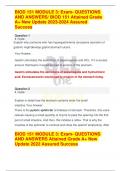Biod 151 module 3 2024 - Study guides, Class notes & Summaries
Looking for the best study guides, study notes and summaries about Biod 151 module 3 2024? On this page you'll find 212 study documents about Biod 151 module 3 2024.
Page 4 out of 212 results
Sort by
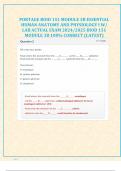
-
PORTAGE BIOD 151 MODULE 3B ESSENTIAL HUMAN ANATOMY AND PHYSIOLOGY I W/ LAB ACTUAL EXAM 2024/2025 BIOD 151 MODULE 3B 100% CORRECT (LATEST)
- Exam (elaborations) • 18 pages • 2024
- Available in package deal
-
- $20.99
- + learn more
PORTAGE BIOD 151 MODULE 3B ESSENTIAL HUMAN ANATOMY AND PHYSIOLOGY I W/ LAB ACTUAL EXAM 2024/2025 BIOD 151 MODULE 3B 100% CORRECT (LATEST)
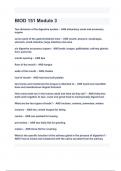
-
BIOD 151 Module 3 Exam Questions with correct Answers 2024/2025( A+ GRADED 100% VERIFIED).
- Exam (elaborations) • 8 pages • 2024
- Available in package deal
-
- $11.49
- + learn more
BIOD 151 Module 3 Exam Questions with correct Answers 2024/2025( A+ GRADED 100% VERIFIED).
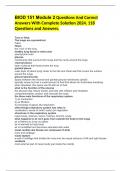
-
BIOD 151 Module 2 Questions And Correct Answers With Complete Solution 2024. 118 Questions and Answers.
- Exam (elaborations) • 8 pages • 2024
- Available in package deal
-
- $10.49
- + learn more
BIOD 151 Module 2 Questions And Correct Answers With Complete Solution 2024. 118 Questions and Answers. True or false. The lungs are symmetrical. False Hilum the "root" of the lung healthy lung tissue is what color peachy/pink color pleurae membranes that surround the lungs and the cavity around the lungs visceral pleura layer of pleura that faces/covers the lung parietal pleura outer layer of pleura lying closer to the ribs and chest wall that covers the surface around the lung...
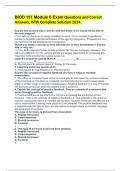
-
BIOD 151 Module 6 Exam Questions and Correct Answers, With Complete Solution 2024.
- Exam (elaborations) • 7 pages • 2024
- Available in package deal
-
- $10.79
- + learn more
BIOD 151 Module 6 Exam Questions and Correct Answers, With Complete Solution 2024. Explain two reasons why a woman with low levels of LH would not be able to become pregnant. (1) LH acts on the ovary to cause ovulation to occur. (2) LH causes progesterone release to facilitate potential fertilization of the egg and pregnancy. Progesterone is a key hormone for the maintenance of pregnancy. Would you expect a female to have testosterone in their bloodstream? Explain why or why not. (1) Yes. ...
BIOD 151 MODULE 3: Exam- QUESTIONS AND ANSWERS/ BIOD 151 Attained Grade A+ New Update 2023-2024 Assured Success
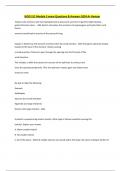
-
BIOD 151 Module 3 exam Questions & Answers 2024 A+ Review
- Exam (elaborations) • 7 pages • 2023
- Available in package deal
-
- $13.89
- + learn more
BIOD 151 Module 3 exam Questions & Answers 2024 A+ Review Explain why someone who has hypergastrinemia (excessive secretion of gastrin) might develop gastric/stomach ulcers. - ANS-Gastrin stimulates the secretions of pepsinogens and hydrochloric acid. Excess amounts would lead to erosion of the stomach lining. Explain in detail how the stomach contents enter the small intestine - ANS-The pyloric sphincter (valve), located at the base of the stomach, relaxes causing a small quantity of ...
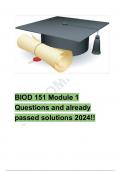
-
BIOD 151 Module 1 Questions and already passed solutions 2024!!
- Exam (elaborations) • 8 pages • 2024
-
- $10.49
- + learn more
BIOD 151 Module 1 Questions and already passed solutions 2024!! There are six levels of organization in the body - what are they? - ANSWER 1) chemical 2) cellular 3) tissue 4) organ structure 5) organ system 6) organism The necessary life function that protects our internal environment from our external environment is provided by what system? - ANSWER The integumentary system The function of movement is provided by what system? - ANSWER The muscular system Th...
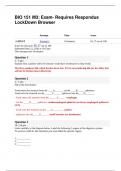
-
BIOD 151 Module 3 exam SPRING 2024 Portage learning
- Exam (elaborations) • 13 pages • 2024
-
- $25.49
- + learn more
Explain why a patient with liver disease would have intolerance to fatty foods. The liver produces bile which breaks down fats. If it is not producing bile (or less bile), fats will not be broken down effectively. Question 2 5 / 5 pts Fill in the four blanks: Food enters the stomach from the ____A_______ via the ____B______ sphincter. Food exits the stomach via the ______C______ sphincter into the____D_______. - Food enters the stomach from the ______A_____ : esophagus - via the _____B_...
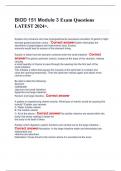
-
Portage Learning BIOD 151 Module 3 Exam Questions LATEST 2024
- Exam (elaborations) • 5 pages • 2024
-
- $10.49
- + learn more
Portage Learning BIOD 151 Module 3 Exam Questions LATEST 2024Portage Learning BIOD 151 Module 3 Exam Questions LATEST 2024Portage Learning BIOD 151 Module 3 Exam Questions LATEST 2024
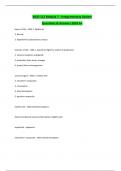
-
BIOD 151 Module 7 - Integumentary System Questions & Answers 2024 A+
- Exam (elaborations) • 8 pages • 2023
- Available in package deal
-
- $9.99
- + learn more
BIOD 151 Module 7 - Integumentary System Questions & Answers 2024 A+ layers of skin - ANS-1. Epidermis 2. Dermis 3. Hypodermis (subcutaneous layer) function of skin - ANS-1. absorb UV light for vitamin D production 2. sensory receptors and glands 3. protection from temp. changes 4. protect from miroorganisms sensory organs - ANS-1. merkel cells 2. missener's corpuscles 3. nociceptors 4. thermoreceptors 5. pacinian corpuscles merkel cells - ANS-mechanoreceptors detect mechanical ...

Did you know that on average a seller on Stuvia earns $82 per month selling study resources? Hmm, hint, hint. Discover all about earning on Stuvia

